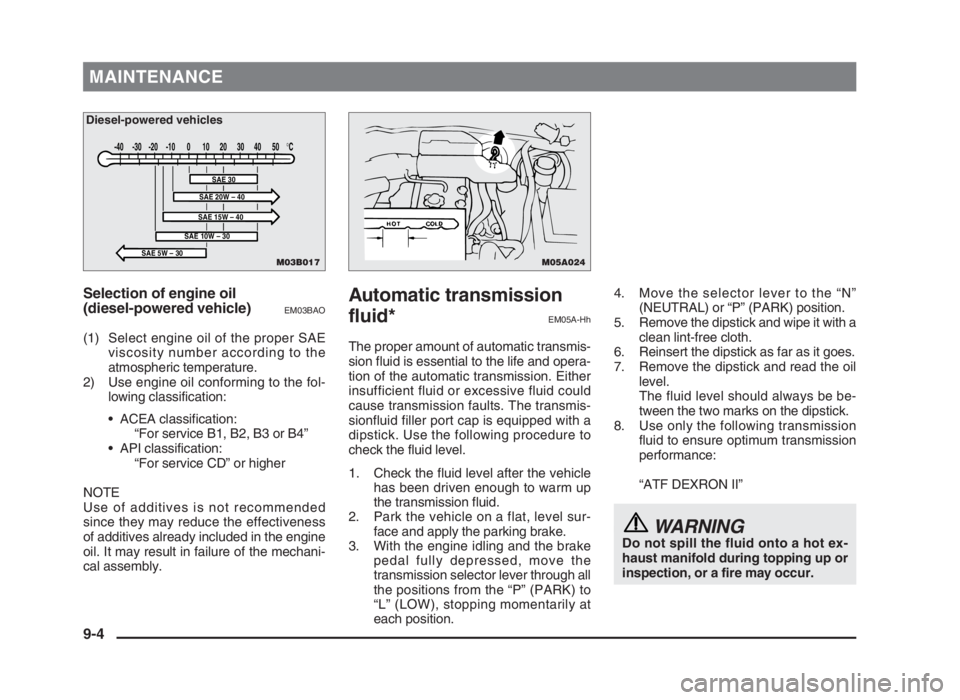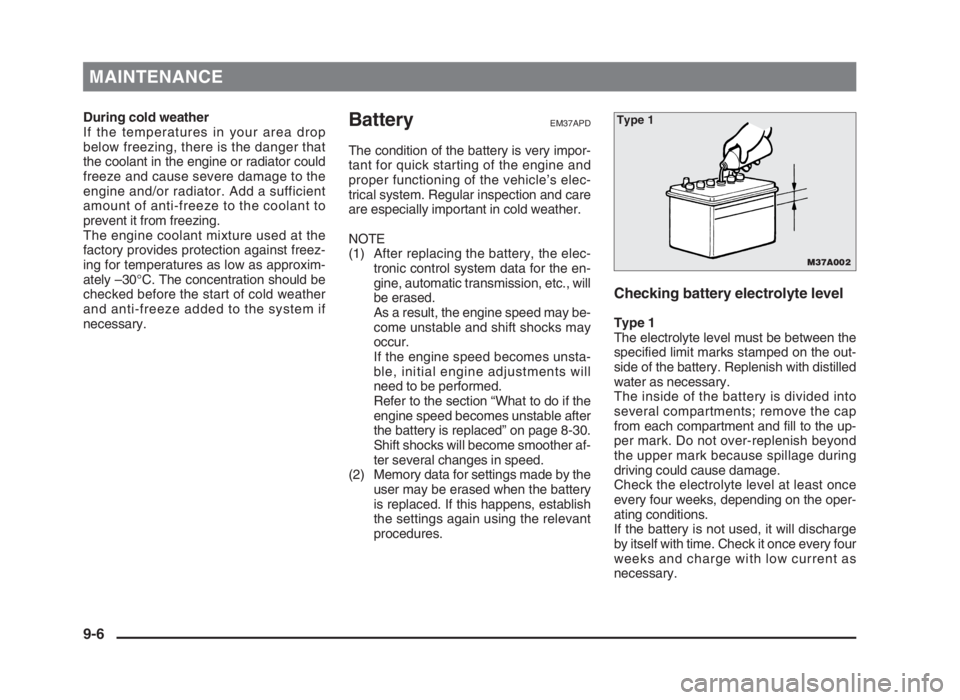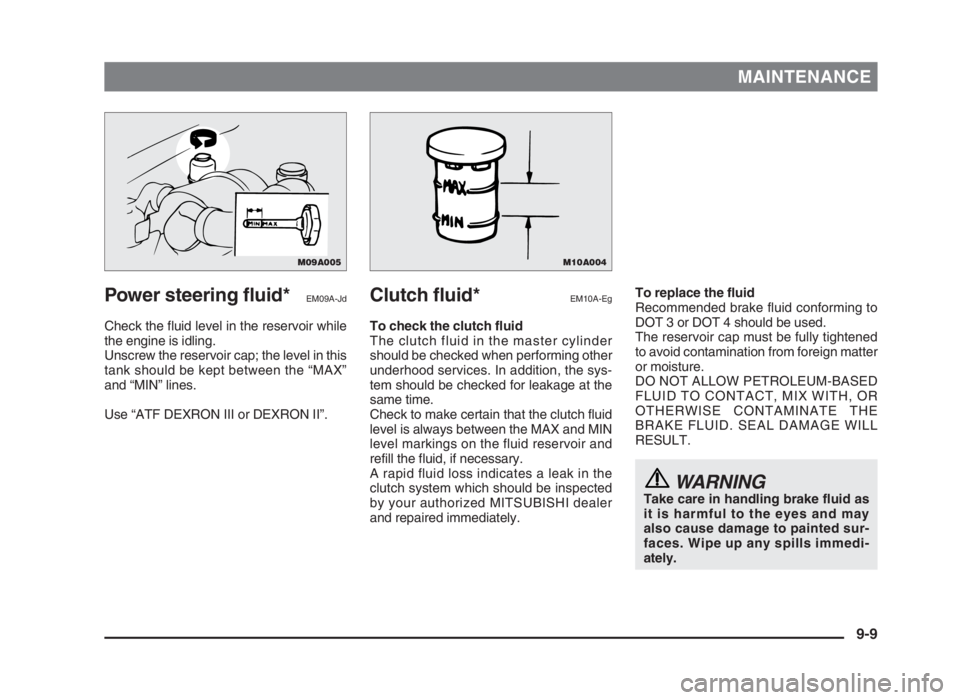engine MITSUBISHI L200 2004 (in English) Manual PDF
[x] Cancel search | Manufacturer: MITSUBISHI, Model Year: 2004, Model line: L200, Model: MITSUBISHI L200 2004Pages: 264, PDF Size: 4.14 MB
Page 206 of 264

FOR EMERGENCIES
NOTE
• Some fuses may not be installed on
your vehicle, depending on the vehicle
model or specifications.
• The table above shows the main equip-
ment corresponding to each fuse.
Engine compartment
NOTE
• Some fuses may not be installed on
your vehicle, depending on the vehicle
model or specifications.
• The table above shows the main equip-
ment corresponding to each fuse.
8-32
N29B131
12
34
56
7
8
910
1112
NoElectrical systemCapacity
1Room lamp10A
2High beam10A
3Tail lamps (Right)10A
4Tail lamps (Left)10A
5Hazard warming
flashers10A
6Air conditioning30A
7Fuse40A
8Ignition switch40A
9Power window30A
10Lamps30A
11Engine20A
12Alternator80A
Symbol
NoElectrical systemCapacity
7Heater relay10A
8Cigarette lighter15A
9Windscreen wiper15A
10Reserving lamps10A
11Meter10A
12Stop lamps10A
13Horn10A
14Power window relay10A
15Automatic transmission
(A/T only)10A
16Fuel line heater15A
17Rear heater10A
18Heated mirror10A
19Demister20A
Symbol
A/T
08engL2_240082_4 22-01-2004 13:11 Page 8-32
Page 215 of 264

Engine oil ................................................................ 9-2
Automatic transmission fluid* .............................. 9-4
Engine coolant ....................................................... 9-5
Battery ..................................................................... 9-6
Brake fluid............................................................... 9-8
Power steering fluid* ............................................. 9-9
Clutch fluid* ............................................................ 9-9
Washer fluid............................................................ 9-10
Wheel condition ..................................................... 9-10
Tyre inflation pressure .......................................... 9-11
Tyre rotation ........................................................... 9-11
Snow tyres .............................................................. 9-12
Tyre chains ............................................................. 9-13
Fuel, engine coolant, oil and exhaust gas
leakage ............................................................. 9-14
Exterior and interior lamp operation .................... 9-14
Meter, gauge and indication/warning lamp
operation .......................................................... 9-14
Clutch pedal free play* .......................................... 9-14
Brake pedal free play ............................................. 9-15
Parking brake lever stroke .................................... 9-15
Hinges and latches lubrication ............................. 9-16
Wiper blades ........................................................... 9-16
Ventilation slots ..................................................... 9-17
Weatherstripping.................................................... 9-17
Additional equipment
(For regions where snow is encountered) .... 9-17
Maintenance
9
09engL2_240082_4 22-01-2004 13:12 Page 9-1
Page 216 of 264

MAINTENANCE
EM01A-Hh
Adequate care of your vehicle at regular
intervals serves to preserve the value and
appearance as long as possible.
Some maintenance items can be carried
out by the owner (do it yourself), while
others should be carried out by an author-
ized MITSUBISHI dealer (periodic inspec-
tion and maintenance). This section de-
scribes only those items which can be car-
ried out by the owner. In the event a
malfunction or other problem is disco-
vered, have it corrected by an authorized
MITSUBISHI dealer. This section contains
information on inspection maintenance
procedures that you can do yourself, if you
wish to do so. Follow the instructions and
cautions for each of the various proce-
dures.WARNING(1) When checking or servicing the
inside of the engine compart-
ment, make sure the engine is
switched off and has had a
chance to cool down.
(2) If it is necessary to do work in
the engine compartment with
the engine running, be espe-
cially careful that your clothing,
hair, etc., does not become
caught by the fan, drive belts, or
other moving parts.
(3) Do not smoke, cause sparks or
allow open flames around fuel or
battery. The fumes are flam-
mable.
(4) Be extremely cautious when
working around the battery. It
contains poisonous and cor-
rosive sulphuric acid.
(5) Do not get under your vehicle
with just the body jack support-
ing it. Always use automotive
jack stands.
(6) Improper handling of compo-
nents and materials used in the
vehicle can endanger your
personal safety.
Consult an authorized MITSU-
BISHI dealer for necessary infor-
mation.
Engine oilEM03A-Dh
The engine oil used has a significant effect
on the engine’s performance, service life
and startability. Only use oil of the recom-
mended quality and appropriate viscosity.
All engines consume a certain amount of
oil during normal operation (See note be-
low). It is important, therefore to check the
oil at regular intervals or before starting a
long journey.
9-2
M03A036
2500 model
09engL2_240082_4 22-01-2004 13:12 Page 9-2
Page 217 of 264

MAINTENANCE
This check must be carried out with the
vehicle on a flat level surface with the en-
gine at normal operating temperature, but
NOT running. If the engine has been run-
ning, wait for a few minutes to allow the
engine oil to return to the oil pan to ensure
an accurate measurement.
Remove the dipstick and wipe it with a
clean cloth, re-insert the dipstick as far as
it will go. Remove the dipstick and check
the oil level. This should always be within
the range as indicated.
If the oil level is below the specified limit,
remove the filler cap located on the rocker
cover and add oil. Then recheck the level.
When satisfied that the level is correct,
refit the oil filler cap making sure that it is
securely fitted.Selection of engine oil
(petrol-powered vehicle)
EM03B-Oe
(1) Select engine oil of the proper SAE
viscosity number according to the
atmospheric temperature.
For 0W-30, 5W-30 and 5W-40 viscos-
ity grade, use only ACEA A3 classifi-
cation.
(2) Use engine oil conforming to the fol-
lowing classification:
• ACEA classification:
“For service A1, A2 or A3”
• API classification:
“For service SG” or higher
NOTE
Use of additives is not recommended
since they may reduce the effectiveness
of additives already included in the engine
oil. It may result in failure of the mechani-
cal assembly. Use only the recommended oils with an
ACEA or API classification as specified in
this manual.
NOTE
(1) Engine oil consumption is greatly
influenced by payload, engine speed,
etc. It may reach 1.0 lit./1,000 km
depending on style of driving.
(2) The engine oil will deteriorate rapidly
if the vehicle is subjected to severe
conditions (for example, repeated op-
eration on rough roads, in mountain-
ous regions, on roads with many up-
hill and downhill gradients, or over
short distances). Consequently, the
oil will require earlier replacement.
(3) For handling of used engine oils, refer
to page 1-16.
9-3
M03A037
2400 model
M03B031
Petrol-powered vehicles
09engL2_240082_4 22-01-2004 13:12 Page 9-3
Page 218 of 264

MAINTENANCE
Selection of engine oil
(diesel-powered vehicle)
EM03BAO
(1) Select engine oil of the proper SAE
viscosity number according to the
atmospheric temperature.
2) Use engine oil conforming to the fol-
lowing classification:
• ACEA classification:
“For service B1, B2, B3 or B4”
• API classification:
“For service CD” or higher
NOTE
Use of additives is not recommended
since they may reduce the effectiveness
of additives already included in the engine
oil. It may result in failure of the mechani-
cal assembly.
Automatic transmission
fluid*
EM05A-Hh
The proper amount of automatic transmis-
sion fluid is essential to the life and opera-
tion of the automatic transmission. Either
insufficient fluid or excessive fluid could
cause transmission faults. The transmis-
sionfluid filler port cap is equipped with a
dipstick. Use the following procedure to
check the fluid level.
1. Check the fluid level after the vehicle
has been driven enough to warm up
the transmission fluid.
2. Park the vehicle on a flat, level sur-
face and apply the parking brake.
3. With the engine idling and the brake
pedal fully depressed, move the
transmission selector lever through all
the positions from the “P” (PARK) to
“L” (LOW), stopping momentarily at
each position.4. Move the selector lever to the “N”
(NEUTRAL) or “P” (PARK) position.
5. Remove the dipstick and wipe it with a
clean lint-free cloth.
6. Reinsert the dipstick as far as it goes.
7. Remove the dipstick and read the oil
level.
The fluid level should always be be-
tween the two marks on the dipstick.
8. Use only the following transmission
fluid to ensure optimum transmission
performance:
“ATF DEXRON II”
WARNINGDo not spill the fluid onto a hot ex-
haust manifold during topping up or
inspection, or a fire may occur.
9-4
M05A024M03B017
-40 -30 -20 -10 0 10 20 30 40 50 °C
SAE 5W – 30SAE 10W – 30
SAE 30
SAE 20W – 40
SAE 15W – 40
Diesel-powered vehicles
09engL2_240082_4 22-01-2004 13:12 Page 9-4
Page 219 of 264

Engine coolantEM36A-Gg
A translucent coolant reserve tank is lo-
cated in the engine compartment. The
coolant level in this tank should be kept
between the “LOW” and “FULL” marks
when measured while the engine is cold.
The cooling system is a closed system
and normally the loss of coolant should be
very slight. A noticeable drop in the
coolant level could indicate leakage. If this
occurs, have the system checked at an
authorized MITSUBISHI dealer as soon
as possible. If the level should drop below
the “LOW” level on the reserve tank, open
the lid and add coolant.
Also, if the reserve tank is completely
empty, remove the radiator cap and add
coolant until the level reaches the filler
neck.
MAINTENANCE
CAUTION(1) Do not use alcohol or methanol
anti-freeze or any engine
coolants mixed with alcohol or
methanol anti-freeze. The use of
an improper anti-freeze can
cause the corrosion of the alu-
minium components.
(2) For effective anti-corrosion and
anti-freeze performance, keep
the anti-freeze concentration
within the range of 30 to 60%.
Concentrations exceeding 60%
will result in a reduction of both
the anti-freeze and cooling per-
formance thus adversely affect-
ing the engine.
(3) Do not top up with water only.
Water by itself reduces the rust-
protective and anti-freeze qual-
ities of the coolant and has a
lower boiling point. It can also
cause damage to the cooling
system if it should freeze. Do not
use tapwater, or it causes the
corrosion and rust formation.
CAUTIONDo not open the radiator cap while
the engine is hot. The coolant sys-
tem is under pressure and any hot
coolant escaping could cause se-
vere burns.
Anti-freeze
The engine coolant contains an ethylene
glycol anti-corrosion agent. The cylinder
head and water pump housing are cast
aluminium alloy, and periodic changing of
the engine coolant is necessary to prevent
corrosion of these parts.
Use MITSUBISHI Genuine Coolant or an
equivalent.
MITSUBISHI Genuine Coolant has excel-
lent protection against corrosion and rust
formation of all metals including alu-
minium and can avoid clogs in the radia-
tor, heater, cylinder head, engine block,
etc.
Because of the necessity of this anti-
corrosion agent, the coolant must not be
replaced with plain water even in summer.
The required concentration of anti-freeze
differs depending on the expected
ambient temperature.
9-5
M36A003
Ambient
temperature
(minimum) °C-15-20-25-30-35-50
Anti-freeze
concentration %303540455060
09engL2_240082_4 22-01-2004 13:12 Page 9-5
Page 220 of 264

MAINTENANCE
During cold weather
If the temperatures in your area drop
below freezing, there is the danger that
the coolant in the engine or radiator could
freeze and cause severe damage to the
engine and/or radiator. Add a sufficient
amount of anti-freeze to the coolant to
prevent it from freezing.
The engine coolant mixture used at the
factory provides protection against freez-
ing for temperatures as low as approxim-
ately –30°C. The concentration should be
checked before the start of cold weather
and anti-freeze added to the system if
necessary.BatteryEM37APD
The condition of the battery is very impor-
tant for quick starting of the engine and
proper functioning of the vehicle’s elec-
trical system. Regular inspection and care
are especially important in cold weather.
NOTE
(1) After replacing the battery, the elec-
tronic control system data for the en-
gine, automatic transmission, etc., will
be erased.
As a result, the engine speed may be-
come unstable and shift shocks may
occur.
If the engine speed becomes unsta-
ble, initial engine adjustments will
need to be performed.
Refer to the section “What to do if the
engine speed becomes unstable after
the battery is replaced” on page 8-30.
Shift shocks will become smoother af-
ter several changes in speed.
(2) Memory data for settings made by the
user may be erased when the battery
is replaced. If this happens, establish
the settings again using the relevant
procedures.
Checking battery electrolyte level
Type 1
The electrolyte level must be between the
specified limit marks stamped on the out-
side of the battery. Replenish with distilled
water as necessary.
The inside of the battery is divided into
several compartments; remove the cap
from each compartment and fill to the up-
per mark. Do not over-replenish beyond
the upper mark because spillage during
driving could cause damage.
Check the electrolyte level at least once
every four weeks, depending on the oper-
ating conditions.
If the battery is not used, it will discharge
by itself with time. Check it once every four
weeks and charge with low current as
necessary.
9-6
M37A002
Type 1
09engL2_240082_4 22-01-2004 13:12 Page 9-6
Page 221 of 264

MAINTENANCE
Type 2
The condition of the battery is very impor-
tant for quick starting of the engine and
proper functioning of the vehicle’s elec-
trical system. Check the condition at regu-
lar intervals and care the battery if neces-
sary.
To determine the battery charge, check
the battery test indicator (1) on top of the
battery.
If the test indicator is seen blue which
looked into it from above, the battery is
okay. If white, the battery requires
charging.
The electrolyte level must be between the
upper line and lower line on the outside of
the battery. Replenish with distilled water
as necessary.
The inside of the battery is divided into
several compartments; remove the cap
from each compartment and fill to the
upper line.
WARNING(1) Keep sparks, cigarettes and
flames away from the battery be-
cause the battery could explode.
(2) The battery electrolyte is ex-
tremely caustic. Do not allow it
to come in contact with your
eyes, skin, clothing, or the
painted surfaces of the vehicle.
Spilled electrolyte should be
flushed immediately with ample
amounts of water.
Irritation to eyes or skin from
contact with electrolyte requires
immediate medical attention.
(3) Ventilate when charging or us-
ing the battery in an enclosed
space.
CAUTION(1) Never disconnect the battery
with the ignition switch “ON”;
doing so could damage the vehi-
cle’s electrical components.
(2) Never short-circuit the battery;
doing so could cause it to over-
heat and damage it.
(3) Always wear protective eye
goggles when working near the
battery.
Do not fill beyond the upper line because
spillage during driving could cause dam-
age.
During cold weather
The capacity of the battery is reduced at
low temperatures. This is an inevitable re-
sult of its chemical and physical proper-
ties. This is why a very cold battery, partic-
ularly one that is not fully charged anyway,
will only deliver a fraction of the starter
current which is normally available.
It is recommended that you have the bat-
tery checked by an authorized MIT-
SUBISHI dealer before the start of cold
weather and, if necessary, have it
charged. This not only ensures reliable
starting, but a battery which is kept fully
charged also has a longer life.
Disconnection and connection
To disconnect the battery cable, stop the
engine, first disconnect the negative (–)
terminal and then the positive (+) terminal.
When connecting the battery, first connect
the positive (+) terminal and then the neg-
ative (–) terminal.
9-7
M37B008
1Type 2
09engL2_240082_4 22-01-2004 13:12 Page 9-7
Page 223 of 264

MAINTENANCE
Power steering fluid*EM09A-Jd
Check the fluid level in the reservoir while
the engine is idling.
Unscrew the reservoir cap; the level in this
tank should be kept between the “MAX”
and “MIN” lines.
Use “ATF DEXRON III or DEXRON II”.To replace the fluid
Recommended brake fluid conforming to
DOT 3 or DOT 4 should be used.
The reservoir cap must be fully tightened
to avoid contamination from foreign matter
or moisture.
DO NOT ALLOW PETROLEUM-BASED
FLUID TO CONTACT, MIX WITH, OR
OTHERWISE CONTAMINATE THE
BRAKE FLUID. SEAL DAMAGE WILL
RESULT.
WARNINGTake care in handling brake fluid as
it is harmful to the eyes and may
also cause damage to painted sur-
faces. Wipe up any spills immedi-
ately.
Clutch fluid*EM10A-Eg
To check the clutch fluid
The clutch fluid in the master cylinder
should be checked when performing other
underhood services. In addition, the sys-
tem should be checked for leakage at the
same time.
Check to make certain that the clutch fluid
level is always between the MAX and MIN
level markings on the fluid reservoir and
refill the fluid, if necessary.
A rapid fluid loss indicates a leak in the
clutch system which should be inspected
by your authorized MITSUBISHI dealer
and repaired immediately.
9-9
M10A004M09A005
09engL2_240082_4 22-01-2004 13:13 Page 9-9
Page 228 of 264

MAINTENANCE
Fuel, engine coolant, oil
and exhaust gas leakage
EM14A-Bd
Look under the body of your vehicle to
check for fuel, engine coolant, oil and
exhaust gas leaks.
WARNINGIf you see a suspicious fuel leak or if
you smell fuel, do not operate the
vehicle; call your authorized MIT-
SUBISHI dealer for assistance.
Exterior and interior lamp
operation
EM35A-Ad
Operate the combination lamp switch to
check that all lamps are functioning
properly.
If the lamps do not illuminate, the probable
cause is a blown fuse or defective lamp
bulb. Check the fuses first. If there is no
blown fuse, check the lamp bulbs.
For information regarding the inspection
and replacement of the fuses and the
lamp bulbs, refer to the section entitled
“For emergencies”.
If the fuses and bulbs are all OK, take the
vehicle to an authorized MITSUBISHI
dealer for inspection and repair.
Meter, gauge and
indication/warning lamp
operation
Run the engine to check the operation of
all meters, gauges, and indication/warning
lamps.
If there is anything wrong, take the vehicle
to an authorized MITSUBISHI dealer for
inspection.
Clutch pedal free play*EM17A-Ya
Press down the clutch pedal with your
fingers until initial resistance is felt.
This distance should be within the speci-
fied range.
A - Free play 6 to 13 mm
If the clutch pedal free play is outside the
standard range, have the clutch pedal ad-
justed at an authorized MITSUBISHI
dealer.
9-14
M18A002
A
09engL2_240082_4 22-01-2004 13:13 Page 9-14